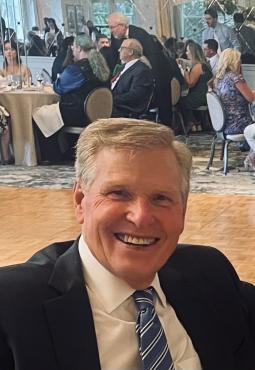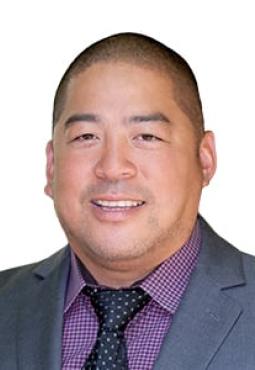
Many patients who come to City of Hope have never heard of the institution, never before set foot on the Duarte campus.
The same cannot be said of Kevin O’Connor. He knows the place so well and has visited so many times, he could give tours.
In fact, he actually does.
O’Connor, a retired furniture company executive living in Greensboro, North Carolina, is a driving force behind City of Hope’s International Home Furnishings Industry group, a 58-year-old fundraising effort that collects some $2 million each year. O’Connor has chaired the group’s annual Spirit of Life® awards dinner for more than a decade; he’s the one who brings the dinner honorees to Duarte and shows them around. O’Connor was himself honored at the 2007 event.
Even with his long, successful career running major furniture companies around the world, O’Connor calls his work on behalf of City of Hope “probably the most important thing I’ve ever done in my life.” It’s clear his words come from a personal place.
O’Connor’s wife Madeline has been treated for breast cancer. Their daughter Christine fought an 8½ year battle with the disease before succumbing at the age of 38. Two of the drugs Christine received were developed through research conducted at City of Hope, enabling her to live longer, “and she got to know her kids, and they got to know their mom,” he said.
O’Connor resolved to deepen his involvement with City of Hope to honor his daughter and because “I didn’t want another father to go through what I went through.”
He dove in, raising money among his colleagues and competitors, speaking forcefully and glowingly about City of Hope, dutifully stressing the “body and soul” philosophy that pervades the place.
But he freely admits he never fully understood the depth of that philosophy until late in 2022 when he experienced it for himself — as a patient.
Unusual Stomach Pain
In November, O’Connor began feeling stomach distress. His North Carolina doctors suspected diverticulitis and prescribed medication and a special diet. But a radiologist detected a cyst on O’Connor’s left kidney. Further tests confirmed it, and O’Connor was told there was an 80-90% chance the mass was cancerous, although it appeared to be self-contained and had not spread.
“It was surreal,” recalled O’Connor. “It’s a whole lot different when someone tells you, ‘You’ve got cancer’ as opposed to having a daughter who has cancer or a spouse who has cancer or a friend who has cancer. Kinda hits you hard.”
O’Connor discussed surgical options — including a procedure to freeze the tumor — with his doctors, but he wanted a second opinion, and he knew just who to ask. He sent his files to an old friend, Yuman Fong, M.D., City of Hope’s Sangiacomo Family Chair in Surgical Oncology. They had met years earlier at a City of Hope function; O’Connor had even raised money to fund Fong’s research.
Fong responded immediately and unequivocally, O’Connor recalled. Don’t get treated there, he said. Don’t do the freezing procedure — the mass is too big. Come out here. We’ll take care of you.
Before long, O’Connor and Madeline were headed to Southern California. They arrived on March 2. Surgery was scheduled for March 4.
Robotic Surgery

“Surgery is the standard of care for this kind of cancer,” said urologic surgeon Clayton Lau, M.D., Pauline & Martin Collins Family Chair in Urology. “It works better than radiation or chemotherapy.”
Unlike Fong, Lau did not know O’Connor well. They met face-to-face for the first time on the morning of the surgery, but they took an instant liking to each other.
“He’s a nice person,” said Lau, “an easy guy to talk to.”
Right back at you, said O’Connor.
“He [Lau] is a great guy. Gregarious, easygoing, diverse interests. He’s a nice, warm person, a real human being, not some ‘clinical’ type.”
Lau opted to perform the surgery robotically, saying O’Connor was “a great candidate” for it. In fact, robot-assisted surgery has rapidly become the new normal for such cases at City of Hope because of its many advantages. Instead of one large incision, a robotic procedure uses five small ones, enabling instruments to perform ever more complex procedures with less bleeding and pain and quicker recovery.
The techniques, instruments and machines constantly improve. City of Hope surgeons use sixth-generation da Vinci robots, which “eliminate the shaky tremors of hands,” said Lau. Magnification is “12 times the human eye,” he said. And now that surgeons and staff have had years to learn and acclimate, a robotic procedure — which used to take considerably longer than open surgery — can be nearly as fast.
Even better, patients receiving robotic surgery are much more likely to be able to return home the same day. Recognizing this, City of Hope operates an Outpatient Surgery Center where urologic, gynecological, breast and plastic surgeries are performed. Lau says the Outpatient Surgery Center is the busiest facility of its kind in the western U.S. It is outfitted with four operating rooms, another four procedure rooms, 26 pre-op and recovery spaces and a staff geared toward maximum efficiency. “Patients don’t want to wait around,” said Lau.
O’Connor’s three-hour procedure went well, with no complications. Lau removed the mass along with about 15% of the kidney. “That’s typical,” said Lau. “Sometimes we remove up to 50%.”
Then came the surprise.
An Unexpected Outcome
Pathology tests on the mass determined it was benign. O’Connor didn’t have cancer after all. He was profoundly relieved and grateful.
But how does an “80-90% cancer” turn out to be something else? And had he known beforehand, would Lau still have operated?
“The only way to know for certain,” explained Lau, “is to cut out [part of it] and do a biopsy. But that carries its own potential complications. And even if we knew it was benign, it still had a chance to grow and cause bleeding, so it still needed to be removed.”
In a thank you note to Robert Stone, chief executive officer and the Helen and Morgan Chu Chief Executive Officer Distinguished Chair, O’Connor raved about getting the “red carpet” treatment at City of Hope. Well, of course he did, you might say. He’s a VIP. A longtime supporter and fundraiser. A frequent guest who has befriended so many of the staff. If anyone merits a crimson rug rollout, it’s Kevin O’Connor!
But what about Joe Nobody who comes to City of Hope with the same illness? What will his medical treatment look like? How will the doctors, nurses and all the rest behave toward him?
Both Lau and O’Connor answered instantly:
“Exactly the same.”
“Nobody in the operating room knew I was a VIP,” O’Connor said. “This is how people are at City of Hope.” He recalled a conversation with a fellow patient who received identically courteous, hold-the-door-open-for-you service, and had marveled at it. This patient actually asked about the level of hospitality training required to develop such a high level of performance. He was told that hardly any training was done: People join City of Hope because they believe in the body-and-soul mission. As O’Connor told Stone, “Someone is hiring the right people, and you are all drinking the same Kool-Aid!”
Lau couldn’t agree more.
“City of Hope focuses on each patient. We think about them, what they need, before, during and after treatment,” he said.
O’Connor says his perspective on City of Hope has become even more meaningful now, having “walked the walk” as well as “talked the talk.” He says he’s gone from being a “believer” to a “super believer.”
So, what about that next tour with the Spirit of Life honorees? Will it be any different?
“You know, the doctors can talk about the ‘hard’ evidence. But I can tell the ‘soft side’ better now,” he said. “I had always believed the stories, pitched the stories. But when you get there, when you see in action everything you’d thought, I realized that it’s all real.”
Main image: An illustration of human kidneys.
